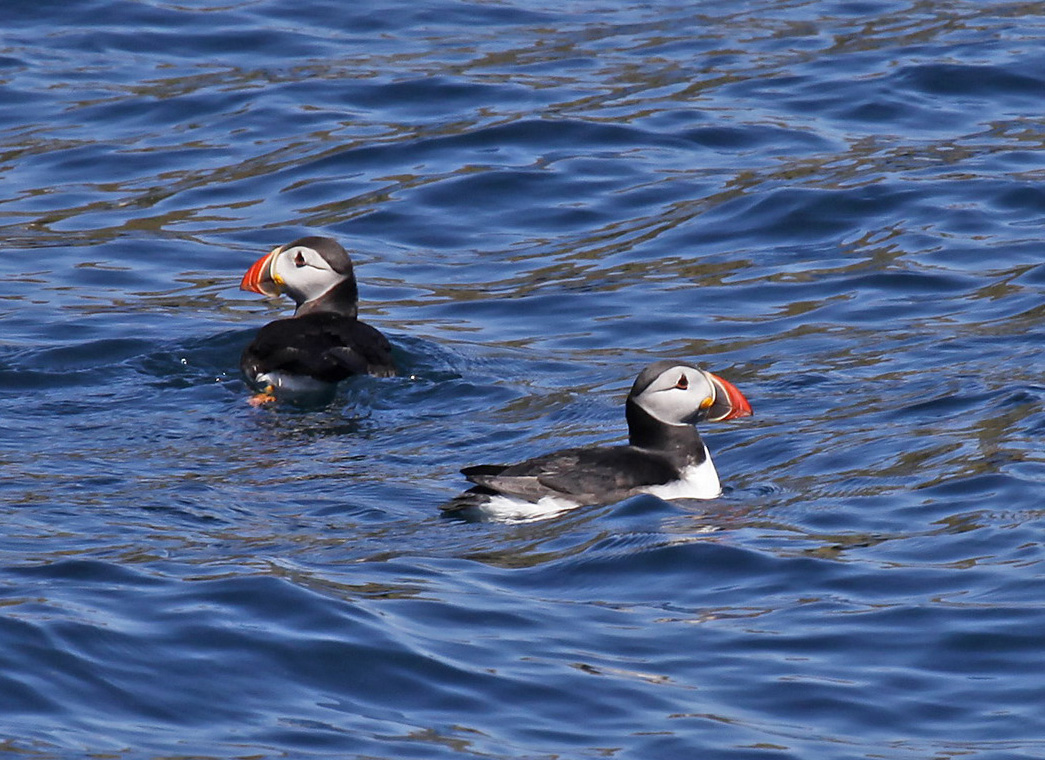The Galapagos Islands of Europe - Blasket Islands & Skellig Rock

Puffins on the water around the outer Blasket Islands
Video
There are a group of Islands in the Gulf Stream.....
There are a group of islands off the Irish S.W. coast which in many ways can be seen as the equivalent of the Galapagos Islands as they have a varied and diverse population of breeding, resident and migratory seabirds [63 species]; the largest seal colony in Ireland with up to 2,000 grey seals hauling out on the Trá Bán [White Strand] during the winter time; and surrounded by a plankton-rich and forage fish rich sea which is frequented by a wide selection of cetaceans and others including harbour porpoises, dolphins - common, Risso's and bottlenose, Minke whales and humpback whales, basking shark, killer whales, sunfish, leatherback turtles, and in more recent times Portuguese man-o- war, By-the-wind-sailors, albacore tuna and bluefin tuna.
The islands are noted for holding the biggest population of European storm petrels (Hydrobates pelagicus) in the world and just across Dingle Bay on the small Skellig one of the biggest gannetries [Sula bassana] in Europe with over 35,000 breeding pairs. Leach's petrels (Oceanodroma leucorrhoa) also breed on the islands, as well as a flock of circa 150 Arctic terns (Sterna paradisaea) the little sea-swallow that migrates further than any bird in the entire world going from high northern latitudes, down the west coast of Africa, right down to the wild Southern Ocean, where he is blown around the bottom of the world by the Roaring Forties and flies back up by the east coast of Brazil to the high northern latitudes again to his lovely summer home on the Blaskets to breed again the following year if his home is still safe and secure. The islands also formerly included an over-wintering flock (circa 200) of Greenland white-fronted geese ( Anser albifrons) until the habitat was degraded by over-grazing sheep. Both peregrines (Falco peregrinus) and choughs (Pyrrhocorax pyrrhocorax) breed successfully on the islands.
Blasket Islands SAC [Special Area of Conservation] and SPA [Special Protected Area]
This wonderful wonderland of nature is a European designated SAC [marine and terrestrial] with particular reference to harbour porpoises, grey seals, vegetated sea cliffs, raised dry heaths, sea caves and reefs and their associated flora and fauna and also SPA for birds including the amazing birdlife previously mentioned as well as puffins, Manx shearwaters, razorbills, common and black guillemots, kittiwakes, fulmars, oystercatchers, Great black-backed gulls. Lesser black-backed gulls, herring gulls, shags, cormorants, ravens, choughs and peregrines and lots of interesting Spring and Autumn passage migrants and vagrants mentioned in previous blogs.
Yet this jewel of European marine and avian wildlife has no permanent wildlife warden, minimal wildlife protection and no Management or Conservation Plan as required under the relevant EU legislation for the proper management of both SAC and SPA.
The status of the breeding seabirds in particular is unknown as no one is keeping an accurate count of numbers or breeding success and thus trends in population increase / decline cannot be ascertained.
A worrying threat is the presence of American mink (Neovision vision)on the Great Blasket Island and an attempt by the NPWS to eliminate American mink from the island has been abandoned due to concerns (possibly rightly) from an animal welfare group.
But without eliminating them humanely from the Great Blasket Island they will inevitably spread to the other islands in the group with devastating effect for the ground nesting birds there including the underground burrowing puffins and Manx shearwaters; the storm petrels nesting in crevices in the dry stone walls; the Arctic terns nesting on small sea-rounded pebbles on the gravelly beaches; the choughs on cliff ledges and in caves and the ground nesting herring gulls, skylarks, meadow pipits and twites. There is also an animal welfare issue for these nesting birds and chicks, as well as an ecological imperative to protect them.
SANCTUARY FOR THE IRISH MOUNTAIN HARE (LEPUS TIMIDUS HIBERNICUS) AND RED DEER (CERVUS ELAPHUS)
The islands (including Skellig Rock) have some very interesting fauna, not least a subspecies of field mouse (Apodemus sylvaticus) originally identified by R.J. Douthwaite in 1966 and James Fairley in July 1977. They are larger than field mice on the mainland or British Isles, have a very long tail almost equal to head and body length and extended hind feet, probably from the steep terrain, but there is a danger that they too may be eradicated by the presence of the American mink. *[c.f. notes at bottom for more detail on physiology / morphology]
The rabbits, which first came to Ireland with the Normans in the 12th century, have reduced in population but the introduction of an indigenous species - the Irish mountain hare - is successful and the population is flourishing. Perhaps over time they too will develop even longer hind legs like the field mice!
On Inishvickillaun "native" red deer have been introduced very successfully to replace the 200 sheep that formerly grazed there. They are not true natives unlike the mountain hare who survived on the mountain tops during the last ice age with the Irish stoat (Mustela ermine hibernicus) and some other notables. "Native" red deer were reintroduced to Ireland again sometime after the retreat of the glaciers.
The undersea world around the Blaskets is pristine with dense kelp forests out to a depth of about 10 fathoms; many undersea reefs, canyons and sea walls populated with a broad and rich variety of green, turquoise, fuchsia and purple coloured anemones including jewel, plumose and elegant; algae - brown, red and yellow; red and yellow sponges (massive and encrusting); brilliant white sagartia; bryozoans; hydroids; orange coloured Deadman's fingers and apricot tinted rose-coral; and all the fish and marine invertebrates that inhabit a healthy marine ecosystem such as lobster, crawfish and crab, conger eel, ling, angler fish, lumpfish (sea hens), sea scorpion fish, baleen and cuckoo wrasses and a wide range of commercially exploited fish. A dazzling wonderland that needs the protection of European legislation if it is to survive the onslaught of various threats.
Setting up a bird observatory on this most westerly European archipelago with resident international scientists and all-year round resident wildlife wardens (two for safety and company) should be a minimum requirement in order to properly protect the European designated Blasket Islands SAC and SPA for posterity.
*Great Blasket Island field mouse (Apodemus sylvaticus hibernicus) Weight 38.1 grams (mature male) tail 106mm (from specimen with 110mm overall head and body length) hind feet 26.3mm. Biggest specimen measured had 116mm overall head and body length and 106mm tail length. May also be present on Skellig Michael.
It would be ironic and indicative in the extreme if 50 years after this subspecies was first measured by R.J. Douthwaite in 1966 on the Great Blasket Island this subspecies were to disappear due to lack of supervision and protection in an EU protected SAC and SPA. It is many years since the writer of this article first watched this oddity playing around his feet while living / fishing from the Great Blasket Island. [There are four distinctly "Irish" subspecies of birds - dipper, coal tit, red grouse and jay- and three "Irish" subspecies of mammals - Irish mountain hare, Irish stoat and Irish field mouse [Blaskets only] - and two are living side by side on the Great Blasket Island, unprotected]
















